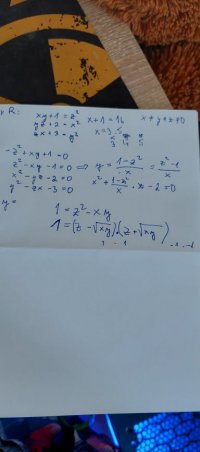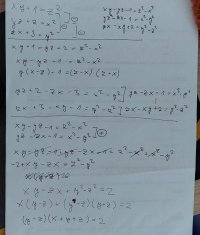Solve the system of equations in the field of real numbers
- Thread starter OlkoBolko
- Start date
D
Deleted member 4993
Guest
Please tell us what you have tried andxy + 1 = z^2
yz + 2 = x^2
zx + 3 = y^2
Exactly where you are stuck!!
First of all, I tried to guess lol, I wanted z^2 to be 16, so x must be 3 and y 5, but other equations don't fit. So I tried to rewrite equations into form like: z^2-xy-1=0 etc. (find some perfect square, but then I realized I have 3 unknown), then I tried to deduce y so: y = (z^2-)/x and put it into the second equation. Then I realised that if I want to deduce another unknown I have to square root, but there will be trouble with the absolute value (something^2 and then sqrt ). So I was stuck again. After one hour of thinking I took the first equation and rewrite it as:1 = z^2 -xy, what is a formula for a^2-b^2 and then thinking, when is the multiplication of two numbers equal to one (1*1 or (-1) * (-1)). Here my adventure ends.
Dr.Peterson
Elite Member
- Joined
- Nov 12, 2017
- Messages
- 16,821
Here's an idea: Try subtracting each pair of equations, and do some factoring.xy + 1 = z^2
yz + 2 = x^2
zx + 3 = y^2
There may be some other similar things you can do, such as multiplying each equation by something and adding them all together.
Otis
Elite Member
- Joined
- Apr 22, 2015
- Messages
- 4,592
I found that two basic factorization patterns (with an educated guess and substitutions) led to a solution with fairly easy algebra. These "cyclical" type systems can have more than one solution, however, and I didn't go back to check additional cases after I'd verified the one I'd found.
Dr. Peterson likely has something more concrete in mind.
?
Dr. Peterson likely has something more concrete in mind.
Subtract the constants, from each side of the given equations. Factor. Make assumptions and substitutions, to obtain an equation in x. Solve and start checking cases.
Lots of grunt work, in that approach.
Lots of grunt work, in that approach.
?
Dr.Peterson
Elite Member
- Joined
- Nov 12, 2017
- Messages
- 16,821
You did some of the work I did, but didn't do it consistently. You got

but the two other differences can also be expressed similarly, which you didn't do.
You didn't make use of the common factor (x-z), which leads to a nice result. (Once something is factored, leave it factored until there is a good reason to expand it.)
In another case you didn't do the same kind of factoring, but somehow did eventually get the nice form that factoring would have led to:

This, similarly, is one of three similar results; but it is the other two that can then be combined to result in a very fruitful way.
but the two other differences can also be expressed similarly, which you didn't do.
You didn't make use of the common factor (x-z), which leads to a nice result. (Once something is factored, leave it factored until there is a good reason to expand it.)
In another case you didn't do the same kind of factoring, but somehow did eventually get the nice form that factoring would have led to:
This, similarly, is one of three similar results; but it is the other two that can then be combined to result in a very fruitful way.
D
Deleted member 4993
Guest
Some steps following Dr.P's advice:xy + 1 = z^2 ................................... (1)
yz + 2 = x^2 ................................... (2)
zx + 3 = y^2 ................................... (3)
subtract (2) from (1)
(xy - yz) - 1 = z^2 - x^2
-y(z-x) - (z-x)(z+x) = 1
(z-x)(z+x + y) = -1 ..................................(4)
similarly {2 - 3}
(x - y)(x + y + z) = -1 ..................................(5)
and {3 -1}
(y - z)(x + y + z) = 2 ..................................(6)
Now divide [(4) by (5)] and [(6) by (5)] and and [(6) by (4)] .........................what do you get?
I get (z-x)/(x-y)=1 , (y-z)/(x-y)=(-2) , (y-z)/(z-x)=(-2)Some steps following Dr.P's advice:
subtract (2) from (1)
(xy - yz) - 1 = z^2 - x^2
-y(z-x) - (z-x)(z+x) = 1
(z-x)(z+x + y) = -1 ..................................(4)
similarly {2 - 3}
(x - y)(x + y + z) = -1 ..................................(5)
and {3 -1}
(y - z)(x + y + z) = 2 ..................................(6)
Now divide [(4) by (5)] and [(6) by (5)] and and [(6) by (4)] .........................what do you get?
Dr.Peterson
Elite Member
- Joined
- Nov 12, 2017
- Messages
- 16,821
Rather than divide, I subtracted 4 and 5; this avoids the assumption that no factor is zero. But otherwise it leads to the same result: a linear relationship among the variables.Some steps following Dr.P's advice:
subtract (2) from (1)
(xy - yz) - 1 = z^2 - x^2
-y(z-x) - (z-x)(z+x) = 1
(z-x)(z+x + y) = -1 ..................................(4)
similarly {2 - 3}
(x - y)(x + y + z) = -1 ..................................(5)
and {3 -1}
(y - z)(x + y + z) = 2 ..................................(6)
Now divide [(4) by (5)] and [(6) by (5)] and and [(6) by (4)] .........................what do you get?
D
Deleted member 4993
Guest
so the next step:I get (z-x)/(x-y)=1 , (y-z)/(x-y)=(-2) , (y-z)/(z-x)=(-2)
(z-x)/(x-y) = 1 → z - x = x - y → -2x + y + z = 0
(y-z) / (x-y) = (-2) → ??
(y-z) / (z-x) = (-2) → ??
You will get 3 linear-equations for 3 unknowns. Solve.
Dr.Peterson
Elite Member
- Joined
- Nov 12, 2017
- Messages
- 16,821
To check that claim, find one solution and check it against the original system. It probably won't work.My 3 linear-equations are -2x+z+y=0 ; 2x-y-z=0 ; -2x+z+y=0 . The first is the same as the third equation, so I have 2 linear equations with 3 unknowns. In my view, there is an unlimited number of solutions.
I think you are forgetting to put the result of this linear equation back into a previous set of equations.


